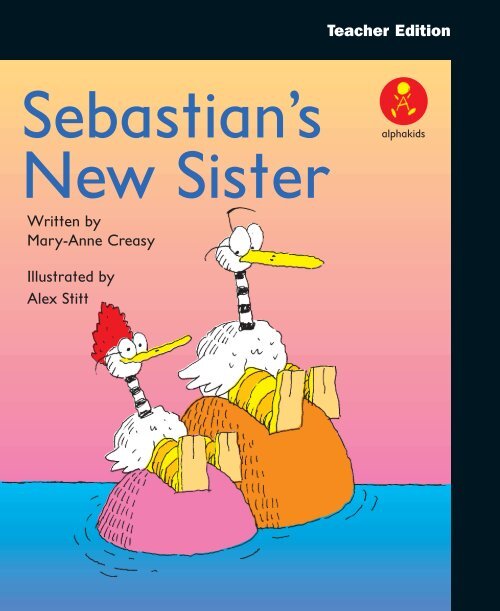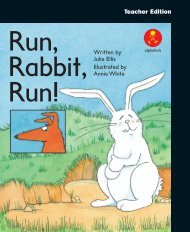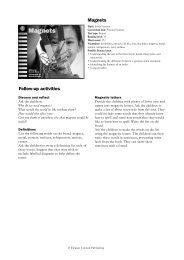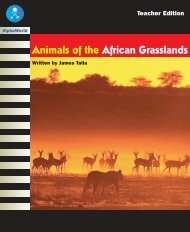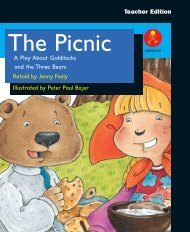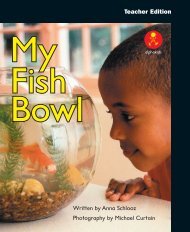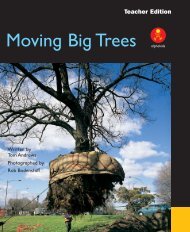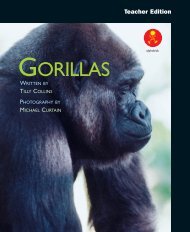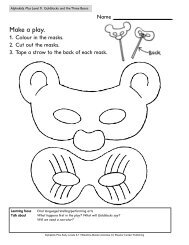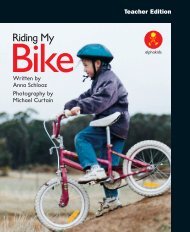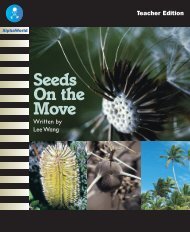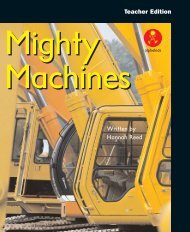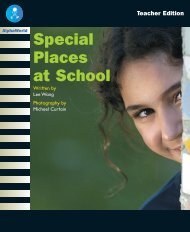Sebastian's New Sister
Sebastian's New Sister
Sebastian's New Sister
You also want an ePaper? Increase the reach of your titles
YUMPU automatically turns print PDFs into web optimized ePapers that Google loves.
Teacher Edition<br />
Sebastian’s<br />
<strong>New</strong> <strong>Sister</strong><br />
Written by<br />
Mary-Anne Creasy<br />
alphakids<br />
Illustrated by<br />
Alex Stitt
Published edition<br />
© Eleanor Curtain<br />
Publishing 2004<br />
First published 2004<br />
Apart from any fair dealing for<br />
the purposes of study, research,<br />
criticism or review, as<br />
permitted under the Copyright<br />
Act of Australia, no part of this<br />
book may be reproduced by<br />
any process, or transmitted in<br />
any form, without permission<br />
of the copyright owner. Where<br />
copies of part or the whole of<br />
this book are made under Part<br />
VB of the Copyright Act, the<br />
law requires that records of<br />
such copying be kept and the<br />
copyright owner is entitled to<br />
claim payment.<br />
Developed by<br />
Eleanor Curtain Publishing<br />
Text: Nicole Di Marco<br />
Consultant: Susan Hill<br />
Designed by<br />
Alexander Stitt<br />
Production by<br />
Publishing Solutions<br />
Printed in China<br />
ISBN 0 7253 3409 6<br />
1 2 3 4 5 6 7 8 9<br />
04 05 06<br />
<br />
How to use this book<br />
Before reading: Talkthrough<br />
Talk through the book with the children. Encourage<br />
them to predict the text from the cover and the<br />
pictures, and to think about the information they<br />
provide. Direct the children’s attention to aspects of<br />
the text that may challenge them. Support the children<br />
to deal with these challenges by asking the<br />
Talkthrough questions on each page.<br />
During reading: Observe and support<br />
Observe the children as they read. Encourage them to<br />
monitor their own reading as they comprehend the<br />
text. As needed, support the children by helping them<br />
to discover and use reading strategies and cues to solve<br />
problems and respond to reading challenges that arise<br />
in the text. Interruptions to the children’s reading<br />
should be minimal and focused on specified learning<br />
needs.<br />
After reading: Comprehension, returning to<br />
the text, responding and writing links<br />
To further develop children’s understanding of the<br />
text, select from activities found on page 16 and the<br />
inside back cover. These whole text, sentence and word<br />
level activities reinforce the teaching focus of this<br />
book. Assessment ideas are provided to assist with<br />
planning for further teaching.<br />
Text highlights<br />
• The book features characters found in<br />
other Alphakids titles, including Sebastian<br />
(Level 9), Hiccups (Level 12) and Sebastian<br />
Learns to Fly (Level 5).<br />
• Direct speech is used.<br />
Vocabulary<br />
anywhere, counted, covered, eyes, hide-andseek,<br />
Isabella, opened, outside, Ruby, sandpit,<br />
Sebastian, yelled
Setting the context<br />
Talk to the children about their experiences<br />
when they have had to play with a younger<br />
brother or sister or any other younger child.<br />
What was it like Did you want to play with<br />
them Could they play the games you like<br />
Introducing the book<br />
This is a book about a bird called Sebastian<br />
who has to play with his baby sister, Ruby.<br />
Front cover<br />
What are Sebastian and his sister Ruby<br />
doing How do you think Sebastian is<br />
feeling Why<br />
Title page<br />
Read the title together.<br />
Point out the names of the author and<br />
illustrator.
Sebastian’s <strong>New</strong> <strong>Sister</strong> Pages 2–3<br />
<br />
Talkthrough<br />
Sebastian has a new sister. Her name is Ruby.<br />
What does Sebastian’s father want him to do Does Sebastian<br />
want to play with Ruby How do you know<br />
Observe and support<br />
Can the children use their knowledge of phonics to<br />
work out new words, such as ‘Ruby’<br />
What does the word start with What does it end with Can you<br />
break the word up<br />
2
Sebastian’s <strong>New</strong> <strong>Sister</strong> Pages 4–5<br />
<br />
Talkthrough<br />
Sebastian and Ruby go outside to play hide-and-seek.<br />
Have you ever played hide-and-seek How do you play it Does<br />
Ruby know how to play<br />
What do you think might happen<br />
Observe and support<br />
Can the children explain the purpose of quotation<br />
marks Point to the quotation marks.<br />
What are these called What do they tell you How do you know<br />
who is talking<br />
4
Sebastian’s <strong>New</strong> <strong>Sister</strong> Pages 6–7<br />
<br />
Talkthrough<br />
Sebastian covered his eyes and counted to ten. What happens<br />
next What does Sebastian say to Ruby<br />
Observe and support<br />
Do the children modulate their voices to indicate that<br />
Ruby is asking a question Point out the question<br />
mark.<br />
How can you change your voice to show that Ruby is asking<br />
Sebastian what ‘hide’ means<br />
6
Sebastian’s <strong>New</strong> <strong>Sister</strong> Pages 8–9<br />
<br />
Talkthrough<br />
What does Sebastian suggest next What happens when he<br />
covers his eyes and counts to ten How does he react to this<br />
Observe and support<br />
Can the children explain the purpose of the arrow in<br />
the illustration<br />
What is this arrow for What does it tell us<br />
8
Sebastian’s <strong>New</strong> <strong>Sister</strong> Pages 10–11<br />
<br />
Talkthrough<br />
Isabella came to play. What does Isabella ask What does<br />
Sebastian discover has happened Is he worried How do you<br />
know<br />
Observe and support<br />
Do the children pay attention to the punctuation to<br />
support expressive reading Point to the exclamation<br />
marks.<br />
What do these exclamation marks tell us How is Sebastian<br />
feeling How might you read these sentences<br />
10
Sebastian’s <strong>New</strong> <strong>Sister</strong> Pages 12–13<br />
<br />
Talkthrough<br />
Look at the pictures on these pages. Where have Sebastian and<br />
Isabella looked for Ruby<br />
Observe and support<br />
Do the children use a range of information on the page<br />
to support their reading<br />
When you looked at the pictures before you read the text, what<br />
were you looking for How did that help you What else did you<br />
check<br />
12
Sebastian’s <strong>New</strong> <strong>Sister</strong> Pages 14–15<br />
<br />
Talkthrough<br />
How will this story end Read to the end of the book and see if<br />
you were right. Where do they find Ruby What does Ruby say<br />
Observe and support<br />
Can the children read the text with expression<br />
How would Sebastian and Isabella be feeling How would you<br />
read the text on page 14 How would you read the sentence,<br />
‘Ruby was there!’<br />
14
Sebastian’s <strong>New</strong> <strong>Sister</strong> Page 16<br />
Talkthrough<br />
Does Ruby know how to play hide-and-seek How do you know<br />
What are the characters going to do now<br />
16<br />
After reading<br />
Being a meaning maker<br />
Encourage the children to support their responses<br />
with evidence from the book as they discuss these<br />
comprehension questions:<br />
What game does Sebastian try to teach Ruby<br />
Why doesn’t Sebastian think Ruby can play at the start of the<br />
book Is he right<br />
Is Ruby too young to play the games that Sebastian likes<br />
What other games might Ruby be able to play
Being a code breaker<br />
Explore the following language features:<br />
• Words that rhyme with ‘play’: bay,<br />
day, gay, hay, lay, may, pay, ray, say,<br />
stay, tray, way.<br />
• Punctuation: explore the use of<br />
quotation marks, question marks and<br />
exclamation marks to support<br />
expressive reading.<br />
Being a text user<br />
Refer to the text when discussing these<br />
questions:<br />
What kind of book is this Is it fact or fiction<br />
Would many children have had the same kind<br />
of experience as Sebastian<br />
Would this add to their enjoyment of the<br />
book<br />
Being a text critic<br />
What does the author think about brothers<br />
and sisters<br />
Are all big brothers like Sebastian<br />
Responding to text<br />
Ask the children to make a map of<br />
Sebastian’s backyard showing all<br />
the places that Sebastian and Isabella<br />
looked for Ruby.<br />
The children could complete a<br />
word substitution activity using<br />
sections of the text. After the activity they<br />
could discuss whether their changes alter<br />
the meaning of the text and whether their<br />
new version makes sense.<br />
Ask the children to look through<br />
this book and other familiar texts<br />
and find words the authors have used<br />
instead of ‘said’.<br />
Writing<br />
Select a sentence from the text that<br />
includes ‘said’ and ask the children to<br />
suggest other words that could fit. They<br />
could then work in pairs through a<br />
number of other sentences that include<br />
‘said’, providing an alternative that may<br />
make each sentence more interesting.<br />
Assessment<br />
Can the children:<br />
• explain who is talking and how this is indicated in the text<br />
• read the text fluently and expressively<br />
whole text activity sentence activity word activity
alphakids<br />
Sebastian’s<br />
<strong>New</strong> <strong>Sister</strong><br />
Written by<br />
Mary-Anne Creasy<br />
Illustrated by<br />
Alex Stitt<br />
Teacher<br />
Edition<br />
Other<br />
books<br />
at this<br />
level<br />
My<br />
Trip<br />
Written by<br />
Mary-Anne Creasy<br />
alphakids<br />
Photography by<br />
Michael Curtain<br />
Topic: Families<br />
Curriculum link: SOSE<br />
Text type: Narrative<br />
Reading level: 10<br />
Word count: 200<br />
High-frequency words: a, am, and, are, came, can,<br />
could, do, had, have, her, his, how, go, in, no, not,<br />
said, she, then, there, they, to, was, we, went, were,<br />
what, when, will, with, yes, you<br />
Vocabulary: anywhere, counted, covered, eyes,<br />
hide-and-seek, Isabella, opened, outside, Ruby,<br />
sandpit, Sebastian, yelled<br />
Baby Bear<br />
Goes Goes Visiting for a Walk<br />
Retold by Jenny Feely<br />
alphakids<br />
Illustrated by Peter Paul Bajer<br />
Reptiles<br />
alphakids<br />
Who’s That<br />
Knocking<br />
At My Door<br />
Retold by Marilyn Woolley<br />
Illustrated by Steve Axelsen<br />
Spiders<br />
alphakids<br />
alphakids<br />
Possible literacy focus<br />
Understanding and using punctuation associated<br />
with direct speech.<br />
Reading dialogue fluently and expressively.<br />
Written by Sarah O’Neil<br />
Written by Hannah Reed<br />
Photography by Patrick Honan<br />
Summary<br />
This book is a narrative about a bird called<br />
Sebastian who tries to play hide-and-seek with his<br />
younger sister.<br />
ISBN 0- 7253- 3409- 6<br />
9 780725 334093<br />
alphakids


